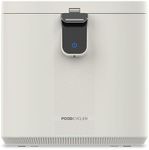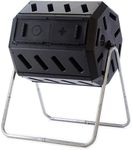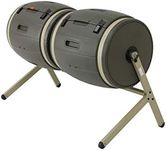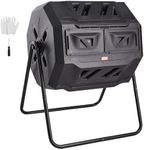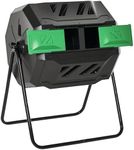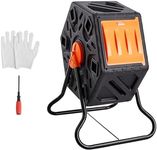Buying Guide for the Best Composting Bins
Choosing the right composting bin can make turning your kitchen and garden waste into rich compost much easier and more effective. The best composting bin for you depends on your available space, the amount of waste you generate, and how involved you want to be in the composting process. Understanding the key features will help you select a bin that fits your lifestyle and composting goals.CapacityCapacity refers to how much material the composting bin can hold, usually measured in liters or gallons. This is important because it determines how much waste you can compost at one time. Small bins (under 50 liters) are suitable for individuals or small households with limited kitchen scraps, while medium bins (50-150 liters) work well for average families. Large bins (over 150 liters) are best for those with big gardens or who generate a lot of organic waste. To pick the right size, consider how much waste you produce and how often you want to empty or turn the compost.
VentilationVentilation refers to the airflow within the composting bin, which is crucial for breaking down organic matter efficiently and preventing bad odors. Bins with good ventilation have holes or slats that allow air to circulate. Minimal ventilation can slow down composting and cause smells, while too much can dry out the compost. If you want a low-maintenance bin, look for one with balanced ventilation that keeps the compost moist but not soggy. If you’re willing to monitor and adjust moisture, you can choose a bin with more or fewer vents.
MaterialComposting bins are typically made from plastic, metal, or wood. Plastic bins are lightweight, weather-resistant, and easy to clean, making them a popular choice for most users. Metal bins are durable and rodent-proof but can rust over time. Wooden bins blend into gardens and provide natural insulation but may rot if not treated. Your choice should depend on your climate, aesthetic preferences, and how much maintenance you’re willing to do.
Access and Ease of UseThis refers to how easy it is to add waste and remove finished compost from the bin. Some bins have removable lids, sliding doors, or bottom access panels. Easy access is important if you want to turn the compost regularly or harvest it without hassle. If you prefer a hands-off approach, a simple top-loading bin may be enough. If you want to speed up composting by turning the pile, look for a bin with features that make this easy.
Pest ResistancePest resistance means how well the bin keeps out rodents, insects, and other animals. Bins with tight-fitting lids and no large gaps are better at keeping pests away. If you live in an area with a lot of wildlife or want to compost food scraps, pest resistance is especially important. Choose a bin with secure closures and sturdy construction if this is a concern for you.
Type (Stationary vs. Tumbler)Composting bins come in stationary (static) and tumbler (rotating) types. Stationary bins sit in one place and require manual turning of the compost, which can be more work but allows for larger capacity. Tumblers are mounted on a frame and can be rotated to mix the compost easily, speeding up the process but usually holding less material. If you want faster compost with less effort, a tumbler may be best. If you have more waste and don’t mind manual turning, a stationary bin could be a better fit.
